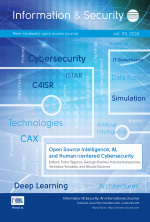Plagiarism, Cheating and Academic Dishonesty – Have You Been There?
Source:
Information & Security: An International Journal,Keywords:
academic dishonesty, ADL, advanced distributed learning, copyright, e-learning, plagiarism, web sourcesAbstract:
It has never been easier for a student, or indeed any other writer, to plagiarise, steal, or cheat from another’s work. The Internet itself is almost a limitless source of information to support this practice. The wholesale copying of data and material has become a simple exercise. Libraries abound with books and publications all of which provide particular ideas, concepts and theories which can be copied, reproduced, or substituted as one’s own. There is little doubt that plagiarism and cheating is ‘academic dishonesty’ which itself is considered by all reputable learning institutions as a serious transgression of academic integrity. In this essay the subject of plagiarism and cheating are discussed within the broader term ‘academic dishonesty.’ Both breaches of academic policy include the deliberate fabrication, falsification, or passing-off and using of someone else’s data, material, concepts, or intellectual property to represent one’s own. To understand what is plagiarism (and hence cheating) there needs to be an accurate definition of the term. This is not so easy to arrive at as plagiarism can range from a writer’s failure to use correct referencing to outright cheating and fraud. So, what controls need to be instituted to thwart plagiarism and cheating? What policies need to be established within an academic institution to outlaw such practices? Are positive rules and procedures required, or is an advisory policy better to encourage students to maintain ethical standards and personal academic discipline? Research has established that plagiarists (and cheats) are aware that their academic dishonesty is counter to institutional norms and practices. Yet what causes an individual to plagiarism, or cheat? Is the academic institution at fault? Should a policy of better academic guidance and ethical motivation be encouraged and advocated to avoid, or minimise plagiarism and cheating and promote original thinking by students? Has the Internet helped to make cheats and plagiarists prosper? This essay is not intended to be provocative. It examines both cheating and plagiarism and the sources of academic dishonesty. Various examples will be considered to alert educators to the need to promote quality research and cognition in an attempt to reduce the likelihood of academic dishonesty by students under their control. The matters that apply in this essay apply equally to the learning environment created through the Partnership for Peace (PfP) Advanced Distributed Learning (ADL) network, as they do in any equivalent ‘Learning Management System’ (LMS).
